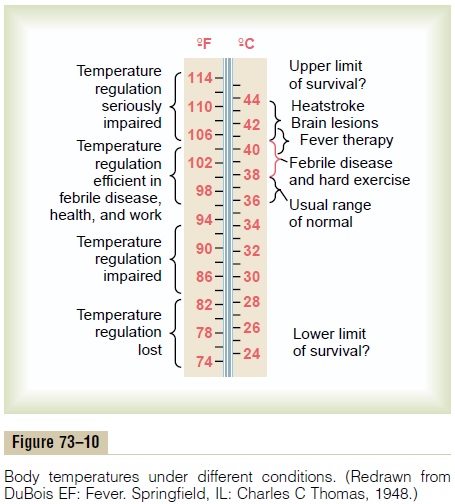Chapter: Medical Physiology: Body Temperature, Temperature Regulation, and Fever
Exposure of the Body to Extreme Cold
Exposure of the Body to Extreme Cold
Unless treated immediately, a person exposed to ice water for 20 to 30 minutes ordinarily dies because of heart standstill or heart fibrillation. By that time, the internal body temperature will have fallen to about 77°F. If warmed rapidly by the application of external heat, the person’s life can often be saved.
Loss of Temperature Regulation at Low Temperatures. As notedin Figure 73–10, once the body temperature has fallen below about 85°F, the ability of the hypothalamus to regulate temperature is lost; it is greatly impaired even when the body temperature falls below about 94°F. Part of the reason for this diminished temperature regula-tion is that the rate of chemical heat production in each cell is depressed almost twofold for each 10°F decrease in body temperature. Also, sleepiness develops (later followed by coma), which depresses the activity of the central nervous system heat control mechanisms and prevents shivering.

Frostbite. When the body is exposed to extremely lowtemperatures, surface areas can freeze; the freezing is called frostbite. This occurs especially in the lobes of the ears and in the digits of the hands and feet. If the freeze has been sufficient to cause extensive formation of ice crystals in the cells, permanent damage usually results, such as permanent circulatory impairment as well as local tissue damage. Often gangrene follows thawing, and the frostbitten areas must be removed surgically.
Cold-Induced Vasodilation Is a Final Protection Against Frostbite at Almost Freezing Temperatures. When thetemperature of tissues falls almost to freezing, the smooth muscle in the vascular wall becomes paralyzed because of the cold itself, and sudden vasodilation occurs, often manifested by a flush of the skin. This mechanism helps prevent frostbite by delivering warm blood to the skin. This mechanism is far less developed in humans than in most lower animals that live in the cold all the time.
Artificial Hypothermia. It is easy to decrease the tempera-ture of a person by first administering a strong sedative to depress the reactivity of the hypothalamic tempera-ture controller and then cooling the person with ice or cooling blankets until the temperature falls. The tem-perature can then be maintained below 90°F for several days to a week or more by continual sprinkling of cool water or alcohol on the body. Such artificial cooling has been used during heart surgery so that the heart can be stopped artificially for many minutes at a time. Cooling to this extent does not cause tissue damage, but it does slow the heart and greatly depresses cell metabolism, so that the body’s cells can survive 30 minutes to more than 1 hour without blood flow during the surgical procedure.
Related Topics